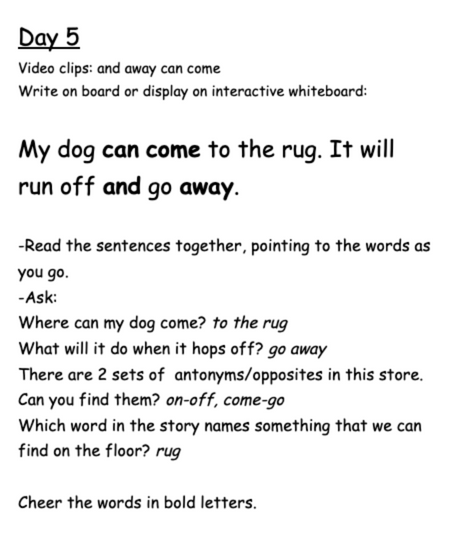Updated So Simple Sight Words Manuals
Feb 23, 2023
Rewriting and updating manuals for So Simple Sight Words was a lot of work and a lot of fun! There’s a manual for each volume, as in the original program, and the words are introduced in the order of the digital videos. Volume 1 has 40 days of instruction, Volume 2 has 35 days of instruction, Volume 3 has 40 days of instruction and Volume 4 has 35 days of instruction. Typically 3 new words are introduced every week throughout all four volumes, and the words learned are repeated throughout the days’ stories and exercises for review, reinforcement, and new instruction for newcomers. In each volume, words from the previous volumes are used and the words from previous volumes in each story are listed at the top of the day’s lesson so you can quickly retrieve them and cheer them using the videos. It’s important to cheer the words in each day’s exercise or story to help newcomers, developing language learners, and students who simply need many repetitions to retain information. It’s good review and “brain exercise” for everyone, and since it involves some music or rhythm and movement, it’s fun!
Volume 1’s daily stories are short and fictional and the exercises are routine-building as well as skill-building. As the Dolch words introduced are level 1, the content of the daily routines are fitting to that level. Volume 2’s stories have more length and skills practice and include review of Volume 1 words. A Volume 3 feature: every 5 days of lessons, ALL the sight word cheer words from volumes 1 and 2 are used so review of what was previously learned is balanced and simple. This really helps your newcomers, emerging English learners, and those students who simply need many repetitions to retain learning. Volume 4 has the same feature. Every 5 days of lessons, ALL the sight word cheer words from Volumes 1, 2, and 3 are used so review of what was previously learned is, again, balanced and simple. You don’t have to “hunt” for anything; the words are all listed at the top of the day’s exercise in alphabetical order by volume so if you use the videos to cheer the sight words they can be easily accessed from your subscription.
I, as a teacher, don’t like to spend a lot of time hunting through text-intensive manuals to see what I really need to DO, so I’ve made it so simple to use this program on a daily basis. Nothing to hunt for, minimal planning, and you have about 15 minutes of your day laid out for you with no mystery! Starting my day with this after singing and dancing was easy, fun, and the lack of prep needed is a bonus, especially if I had a guest teacher. It’s a great “plug and play” way to start your day!
In pre-K, kindergarten, and first grade, I recommend starting with Volume 1. While some of the words may seem “easy” for the students without needing a cheer to read/write them, you will be building a routine of behavior and of your learning expectations. It’s easier to build on these foundations with less-demanding learning material, so start off slowly! Volume 1 does that for you. In pre-K and kindergarten, you may not do every daily exercise to begin. You might just select sight word cheers you need. As the school year progresses, you might then introduce the stories and exercises from the manual. Instead, you might be using the practice sentences and/or the Month of Ideas to reinforce sight word learning with your emerging readers and writers.
In first grade, I recommend using the program as-is in the order of the volumes as the skill levels increase through each volume. While you might have a sight word cheer you wish to introduce earlier than it appears in the program, using the program overall along with those “extras” helps retain learning and having the daily routine lowers the affective filter/stress level. The predictability of the daily story/exercise followed by questions and cheering gives learners a chance for less anxiety. Giving high-anxiety learners (often our ELD learners and our print-deprived learners fall in this category) an opportunity for participation, fun, and success based on routine will follow through the rest of the school day!
Here is a printable list of the sight words included in each volume.

In my own classroom, I printed the sight word cards, laminated, and magnetized them to keep on my white board. This is my “living word wall.” The students can manipulate the words, we can sort them, do alphabetical order activities with them, do cloze activities with them, and play “mystery word” with them. My learners who aren’t yet able to comfortably copy words from a distance often walk to the board, find a word they aren’t owning confidently yet, and take it to their seat to write it then put it back. Having this option can lower anxiety and offer movement in the midst of a left-brained learning activity. (A quick reference article regarding copying from a distance)
150 days of a school year’s routine written, filmed, and scripted allows anyone to feel comfortable using So Simple Sight Words! More experienced instructors will think of other questions to ask along with the daily questions based on what is being taught or focused on with that specific child or group.
Let me give you an example of how many skills can be touched upon using one Volume 1 day’s story:

Additional questions you might ask:
How many sentences are in this story? 2
(Point to the period) What is this? What is it used for? A period, it ends a sentence
What word in the story is the opposite of “walk?” Run
Which words in the story have a double consonant? Off, will
Which word in the story has two syllables? Away
Stay connected with news and updates!
Join our mailing list to receive the latest news and updates from our team.

